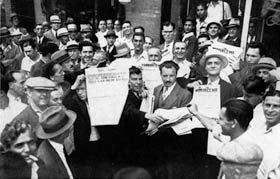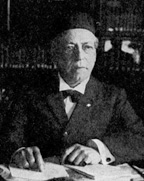 In the 1930s, strikes like the one at the Paterson Silk Factory helped workers secure fair wages and decent working conditions. (Source/Arttoday) |
Off work to celebrate work
The Labor Day holiday as we know it grew out of the efforts of labor unions over a century ago. According to the U.S. Department of Labor, records indicate the holiday was first proposed in the late 19th century. Two men are credited with the original idea: Peter J. McGuire, a co-founder of the American Federation of Labor, and Matthew Maguire, a machinist and secretary of the Central Labor Union in New York.
The purpose of the holiday was, in McGuire's words, to celebrate those "who from rude nature have delved and carved all the grandeur we behold."
Early legislation enacting Labor Day came from the states, led by New York and Oregon (which was the first to make the holiday official in 1887). In 1894, Congress passed the act which made the first Monday in September of each year a holiday.
Labor unions are the negotiators and watchdogs for the American workforce. A means of collectively bargaining with employers for fair wages and decent working conditions, labor unions are organized into two types: craft unions (skilled laborers) and industrial unions (laborers in the same industry, regardless of skill).
Craft guilds and industrial unions
Guilds were the seed of modern labor unions in the U.S. Groups of highly-trained printers, carpenters, tailors, and weavers in the colonial age banded together to maintain quality standards and to ensure employers hired skilled laborers from home.
With the invention of the steam engine and other industrial advancements, the personality of the American workforce began to change. The mid-19th century saw an ever-increasing number of new industrial unions created to fight for workers' rights. One of the most important was the Knights of Labor, which inaugurated the Labor Day holiday in 1882.
The AFL-CIO
The craft unions were opposed to the composition of the Knights of Labor's membership, which included both skilled and unskilled laborers. In the 1890s, many of the craft unions bonded together to form the American Federation of Labor (AFL). Early strikes and conflicts during this period included the United Mine Workers and the Danbury Hatters case in 1902.
During the Great Depression of the 1930s, the Congress of Industrial Organizations (CIO) was formed. Many of the CIO's members were dissidents of the AFL, favoring industrial unionism (some of the CIO's major constituencies were workers in the steel, auto, rubber, glass, maritime, and meat packing industries). Despite conflicts throughout the 30s and 40s, the two national organizations merged to form the powerful body known as the AFL-CIO in 1955.
 Samuel Gompers, a leader in the American Labor Movement, helped to found the AFL in 1886. (Source/Arttoday) |
Labor legislation
Through the leadership of the AFL, the U.S. Department of Labor was established in 1913, and charged with protecting the rights and welfare of all U.S. wage earners. One year later, the important Clayton Act was enacted, which emphasized that "the labor of a human being is not a commodity or article of commerce" and legalized peaceful strikes, picketing, and boycotts.
The administration of President Franklin Delano Roosevelt was instrumental in the labor ovement for urging passage of the National Labor Relations (Wagner) Act of 1935, which enlarged the rights of unions and created the National Labor Relations Board.
FDR's work was later amended by the Taft-Hartley Labor Act. This amendment enlarged the power of the National Labor Relations Board and allowed the federal government to intervene in strikes affecting national health or safety.
The Teamsters
The Teamsters Union is the largest, and perhaps the most contentious, union. Formed in 1903, the labor organization grew rapidly and secured the important membership of the trucking industry thirty years later.
In 1957, the Teamsters were expelled from the AFL-CIO, following a Senate investigation which exposed widespread corruption.
Throughout the 70s and 80s, the union has been marred by the nefarious criminal acts of its leaders (most notably president Jimmy Hoffa, who disappeared in 1975) as well as massive contributions to the campaign of Richard Nixon and the federal suits accusing union officials of tax evasion, mishandling of pension funds, and accepting bribes from employers to stop strikes.
Labor today
Today, the term "labor" can be applied to strong professional unions, the national holiday, and even academic departments in colleges and universities.
The modern American labor movement has grown from its roots in the colonial craft guilds to national professional associations with membership numbering millions. For many, Labor Day may simply signal the end of the summer months. But for the American workforce, the holiday remembers those who have labored for our country since its founding.



